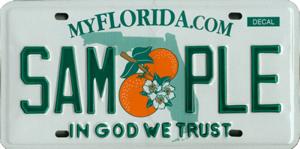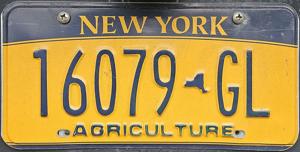Plates and states
I was recently visiting Vermont for a work trip – my first time in the USA since I was a child. I was drawn to the license plates on passing cars, and how they look different to the cars I’m used to.
Whenever I visit new places, I enjoy looking for the tiny bits of infrastructure and design that make life different – stuff that everybody who lives there is used to, but which is novel or unusual to me. The open-plan layout of a telephone booth in Berlin. Slovenian post boxes which are bright yellow. The variety of call buttons used on pedestrian crossings.
These details are only small, but they add up to give every place a unique feel. Often they don’t get written down or recorded, because “everybody knows” how these things work, and they don’t seem remarkable to somebody who experiences them every day. It’s hard to know these things without visiting, because so few people think they’re worth sharing – and many of them are lost to time, forgotten as places change and evolve.
As I looked into US license plates, I learnt more about both American cars and America in general.
Not all states require both plates
In the UK, every car must have a number plate on both the front and back of the car. In the US, it varies by state – some states require both plates, other states only require a rear license plate.
I’d seen US cars without a front license plate in TV shows and movies, and I thought maybe it was a Hollywood thing – special cars used for filming – but no, it turns out that’s perfectly legal in 19 US states. I only realised this was a thing a few weeks ago, when I heard Casey Liss mention “front plate states” in a podcast. Until then, I just took it for granted that all cars have plates on the front and back, because that was what seemed “normal” to me.
I can see why you might prefer to have a car without a front license plate – if it’s a car with a striking design, it looks better without a plate. The aesthetics are why I thought maybe it was a specific choice for film. Google suggests cost is also a factor, although I wonder how much of a difference an extra plate actually makes.
I didn’t see any cars without any front license plates while I was in Vermont. I did see some cars with “Vermont Strong” commemorative plates, plus a few with political slogans I didn’t catch – rather than the registration number of the car.
A bit more research suggests that the US is in a minority – almost everywhere other country requires license plates on both the front and back of the car. I wonder if these 19 US states will continue to be outliers, or if they’ll ever change to match the rest of the world.
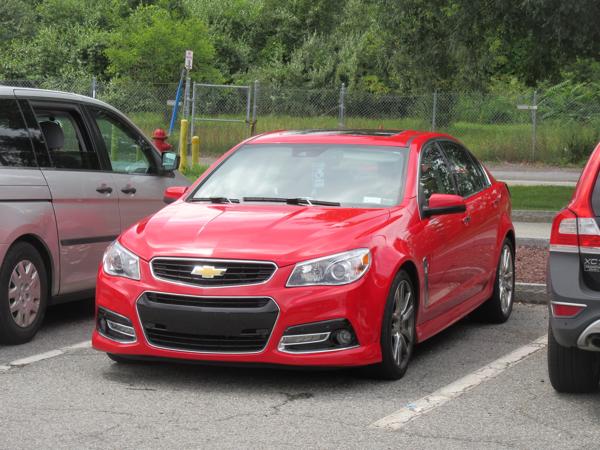
Different plates for different states
In the UK and Europe, the appearance of number plates is tightly regulated – they don’t quite specify a font, but there are strict rules around letter shape, spacing, colour, and so on. When I wander round London, it’s rare for me to see a plate which doesn’t match this style.
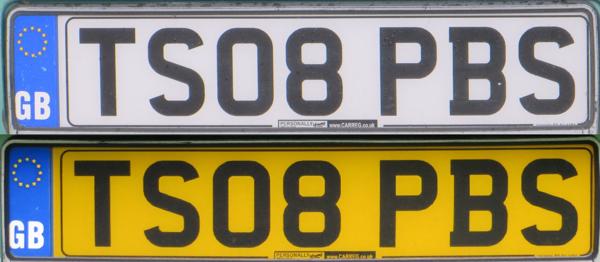
There’s no such consistency in the USA – license plates are an explosion of colour, font, and shape. Every state has different designs, and every state has issued many different designs over history. Pretty much every license plate had the name of the state somewhere on it, but otherwise they didn’t have much in common.
A few designs that stood out to me: “In God We Trust” with an illustration of some oranges (Florida); “Live Free or Die” (New Hampshire); “Green Mountain State” (Vermont). The plates in Vermont were a distinctive shade of green with white text, which matched the verdant scenery.
I didn’t get good pictures from a moving car, but I found examples on Wikimedia Commons:
Personally I find the extra text and graphics distracting, and I think they make the license plates harder to read – but I’m not used to this style. This is my visceral reaction against something unfamiliar, not an objective assessment.
I can see how it adds a sense of personality and identity to a car, in a way that UK number plates are very generic and dull. I see the occasional bumper sticker when driving in the UK, but this is much bolder and brighter.
Does this affect people’s sense of identity or place? My car doesn’t have any marks that tie it to a particular location, and I feel no emotional attachment towards it. Does the link between their car and their home state make Americans feel more connection to either, or both? I wasn’t in the US long enough to notice anything specific, but I wonder what influence it has.
One thing I noticed is that the different plates mean that outsiders stand out. Our rental car was registered in Maine, and our black-on-white plate stood out from the sea of green Vermont plates. This feeling was exacerbated by visiting a small rural town where everyone knows each other, and I was the stranger who nobody knew. (Of course, my British accent marked me as an visitor as well.)
I didn’t realise this variety of license plate designs was a thing until I was on US roads – although I’m sure I’ve seen different plates in US media, it wasn’t until I saw dozens of cars next to each other that it jumped out at me. Standardised number plate designs are another aspect of my life that felt universal, but were really just familiar.
What’s the rate of all the plates?
While I was driving with Jessamyn around Vermont, she pointed out a couple of the more unusual license plates – she was keeping a list of out-of-state plates she saw while out driving. Because she lives in the US, she can recognise a lot of the plates from a distance – I had to squint my eyes and read the text, because it’s all new to me. (I did all this from the passenger seat, don’t worry!)
On the drive back to the airport, from Vermont to Boston, I decided to start my own list. I was surprised by how many different states I spotted – in just three hours, I saw plates from two Canadian provinces (Ontario and Quebec) and twenty-six US states.
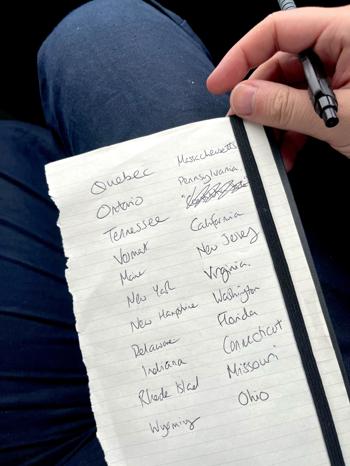
My American geography is lousy and I have no intuition for where these states actually are, so when I got home I plotted them on a map. This helped me see the patterns more clearly.
These are the states whose plates I spotted (with the states we drove through shown in green):
Drawing this map was an educational experience – although I’ve seen a map of the US states lots of times, I’d never looked at it properly.
Most of the states I saw are on the east coast, and that makes sense – we were driving in the northeast. I’d never realised how much denser the states are in the east versus the west – they really are packed in tight. Maybe this is because European colonists arrived on the east coast, and so those areas were more densely populated when the state lines were drawn?
California (far left) is a notable outlier, and I was surprised by just how many cars I saw with those plates – by the end of the trip, I could spot the red faux-handwriting quite easily. Google tells me that California has the most people of any state, which might explain why I saw so many of their cars despite being on the opposite coast.
Washington (top left) is another outlier, and I wonder if I made a mistake here – I know I saw a plate labelled “Washington”, but it turns out Washington DC has its own license plates. Since DC is on the east coast, it’s much more likely I saw a car from there than from a state on far side of the country. Unfortunately I don’t remember what the plate looked like, so I can’t be sure.
While I was in the US, I assumed it was just states who got to issue license plates. Now I know that’s wrong, I wonder if there are other exceptions. Are there any other federal districts or smaller-than-state entities who get to issue their own license plates, or is Washington DC special?
I’ve left Alaska and Hawaii off the map because I didn’t see any of their plates. It’s a long way to drive a car from Alaska, and it’s an expensive job to ship a car from Hawaii – those cars must be pretty rare in the contiguous US.
Drawing this single map has probably helped me internalise more about US geography than anything else. For the first time I’m an active participant in the map – I’m drawing my own data and looking for patterns and causes, not just passively observing data drawn by somebody else.
License plates are fractally interesting
This is only scratching the surface of the complexity of license plates. There’s so much more history, and variety, and design, all of which would be fun to research and write about if I had more time – but I have to stop somewhere.
I describe topics like this as “fractally interesting”. However deep you dig, however much you learn, there’s more to uncover.
This is why I love looking for the seemingly insignificant details in which life in foreign places differs from mine – it might seem small at first, but there’s always something interesting to learn.
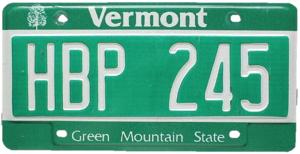
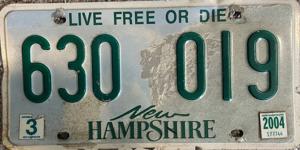
_1x.png)
